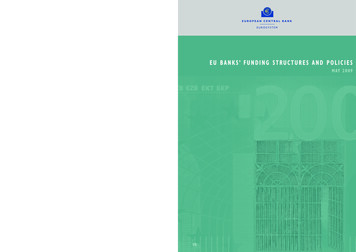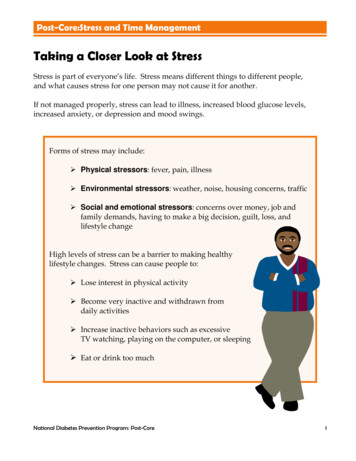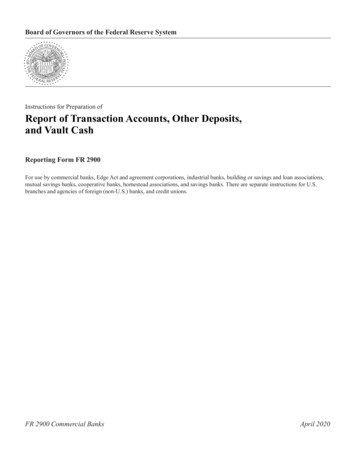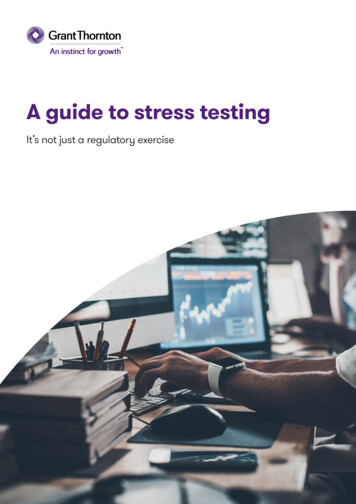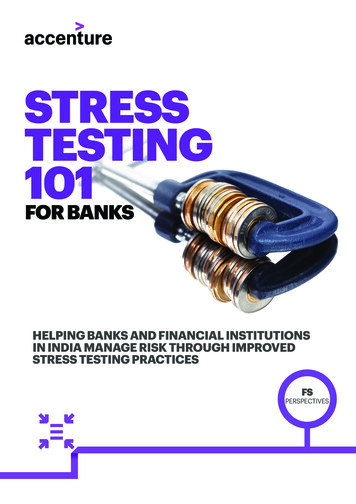
Transcription
FSPERSPECTIVES
Content1STRESS TESTING TO POWER RISKMANAGEMENT SYSTEMS IN BANKS23INDIA UNDER STRESS IN THEGLOBAL RACE452SETTING THE RIGHT FRAMEWORKa. Core areas of stress testingb. Approaches for stress testingTOP-DOWN OR BOTTOM-UP? WHY NOT BOTH?a. Adopting a mixed approach67STRETCHING THE BOUNDARIES: HOWMUCH RISK IS GOOD RISK?STAYING AHEAD OF THE GAMEHOW ACCENTURE CAN HELPThe global financial meltdown in 2008 wasbelieved to be a direct result of sub-optimalstress testing in banks. Lessons learnt, regulatorsacross the world have tightened the surveillanceframework around it.While most countries have come out with stringentrules for stress testing, India is still lagging.This whitepaper highlights the best practicesIndian banks can adopt to strengthen their riskmanagement systems.3
Stresstesting topower riskmanagementsystems inbanksThe 2007–08 global financial crisis was a turning point for banks andfinancial institutions across the world as it put the spotlight on the need formore stringent stress testing practices. Prior to this, stress testing was partof the Internal Capital Adequacy Assessment Program (ICAAP) under theBasel norms. Its scope was limited to supporting policy decisions and wasbeing carried out to merely tick the regulatory exercises checklist. However,the macro scenario was far more severe in many respects than assumed bybanks. Weak stress testing practices further impaired the resilience of banksand financial institutions. This led many banks and supervisory authoritiesacross the world to question whether the existing stress testing practiceswere sufficient and robust to cope with rapidly changing circumstances.Against this backdrop, the Basel Committee on Banking Supervision (BCBS)issued the Principles for Sound Stress Testing Practices and Supervisionin May 2009. This further led regulators to drive investments, develop andimplement stronger stress-testing frameworks globally.4Today, stress testing has emerged as a common tool for financialsupervision and regulation with many countries undertaking relatedreforms. The International Financial Reporting Standard (IFRS) 9 hasprescribed stress testing for banks and financial institutions as an exerciseto determine the volatility in the expected credit loss in baseline andadverse scenarios such as significant deceleration in GDP growth orsharp increase in unemployment rates. The Basel Committee on BankingSupervision (BCBS) is finalising a new set of guidelines to replace the stresstesting principles set in 2009.Most countries have uppedtheir game, India not so muchIn the United States (US), the Federal Reserve Board (FRB) conductsannual reviews of its stress testing processes and scenarios and sharesupdated guidelines with banks. Both large and small financial institutionsare required to report the results to the FRB’s Comprehensive CapitalAnalysis and Review (CCAR) and Dodd-Frank Act Stress Testing (DFAST)respectively. In Europe, similar guidelines were issued in 2017 by theEuropean Banking Authority (EBA) that covers nearly 70 percent of theEuropean Union banking sector.In India, the Reserve Bank of India (RBI) emphasised on stress testingas a risk management tool in its Annual Policy Statement 2006–07 andissued formal guidelines in June 2007. After the global financial crisis of2007–08 and the global outrage on the inefficiency of the existing stresstesting practices, RBI also updated its guidelines in 2013 based on BaselCommittee Principles of May 2009. Banks and financial institutions in thecountry mainly follow the traditional “top-down” approach to implementthese norms. The approach is simple, requires minimal technologyinfrastructure and is quick to compute. However, the model does notadequately assess risks or enable revenue forecasting. As a result, Indianbanks are today weighed down by a high number of non-performingassets (NPAs).Globally, banks and financial institutions are trying to close the gap byaugmenting the results from the top-down approach with a bottom-upapproach, and Indian banks should also be doing that.5
What is stress testing?Stress tests are designed to understand whether a bankhas enough capital to survive plausible adverse economicconditions. These tests are meant to measure the institution’sability to maintain enough buffer to stay afloat under extremescenarios.BUFFERStretching theboundaries:How much riskis good risk?Figure 1: Risk capacity vs. risk exposureStress tests also help assess new capital plans and their riskexposure. For example, in the US, several dividend pay-outs andshare repurchases were rejected1 because they failed the stress testsand their capital levels were found to be inadequate under stressfulscenarios. Although there is no standard on the actual capital a bankmust hold to cover the risk, the buffer should never be negative evenin adverse scenarios (see figure 1).61. PITALEnsure minimum capital ratio to meetthe evolving regulatory requirementsand for the banks to keep going despitesevere losses.SOLVENCYEnsure sufficient total capital (throughCommon Equity Tier 1, loss-absorbingcapital and deferred contingent capitalplan) so that the Probability of default(PD) on debt issued by the bank is in linewith the target debt rating.EARNINGSEarnings should cover the risk of lossesin most years. Repeated quarterly lossesshould be avoided.CREDIT RISKEARNINGSCAPITALREGULATORYREQUIREMENTSMARKET RISKISSUER RISKINVESTMENTRISKLIQUIDITY RISKCOUNTRY RISKRisk capacity vs. risk exposureThe simple objective of stress testing is to keep institutions as agoing concern even during severe economic distress. Institutionsshould balance risk capacity with risk exposure under economic andregulatory constraints. They must maintain a minimum capital ratio(currently, 8 percent), solvency, earnings, minimum leverage ratio(currently, 3 percent, Basel III) and sureREGULATORY Ensure sufficient capital to meetregulatory leverage ratio and remain aLEVERAGEgoing concern despite a severe loss.LIQUIDITYEnsure the firm can survive a severe12-month idiosyncratic and market-widestress without significantly impactingthe franchise.Why should banks adoptstress testing?To begin with, stress testing incentivises banks to implement robust riskmitigation and management practices. It also creates transparency in thebanking system through better data collection and publication.Banks and financial institutions have also realised the potential of the analysesfrom stress tests to feed business intelligence. The focus has now shifted toformulate capital and performance management strategies, capture efficiencyand return on investment.2 Simply put, stress testing is no longer viewed as amere regulatory exercise but a strategic and profitable function.2. https://www.accenture.com/t20170630T023851Z w /us-en/ pdf7
Stress testing can be used to strengthen the following functions (see figure 2):Figure 2: Key areas of an integrated stress testing frameworkRISK APPETITE (RA)Identify growth strategies and corporateRA that could impact the availability anddeployment of capitalCreate business plans linked to capitalstrategies, including capital allocation, riskadjusted performance and incentivesUndertake dynamic monitoring andrecalibration of RA targets and thresholdsBALANCE SHEETMANAGEMENTDynamically manage balance sheetcomposition to improve risk weightedasset (RWA) and build resilience toexternal shocksDetermine “strategic buffer” capitallevels accounting for cyclicalityIdentify enhanced asset-liabilitymanagement (ALM) capabilities linkedto stress scenarios8RISKMANAGEMENTIdentify and assess allmaterial risksEnsure risk managementpolicies and procedures arelinked to capital adequacylevels (e.g. limits)Identify stress scenarios thatimpact liquidity, capital accessand funding requirementsCAPITALMANAGEMENTImprove the sources vs. use of fundsand capital targets formulationRefine capital distribution plans(dividends, repurchases)Identify capital contingency plans,Key Risk Indicators and triggers9
India understress in theglobal raceAs per the RBI,4 only six state-owned banks had more than threepercent gross NPA (GNPA) among all public-sector banks in March 2012.Public sector banks cover more than 70 percent of the Indian bankingsector. The Central Bank of India had the highest GNPA at 4.8 percent.However, as per CARE Ratings,5 by June 2017, the GNPA of most banksshot up to double digits. IDBI Bank rose to 24.11 percent and IndianOverseas Bank touched 23.6 percent.6 Such elevated levels of debtthreaten the very existence of the financial institutions, further leadingto economic slow-down.According to World Bank data,3 India is lagging behind majoreconomies, with a high number of non-performing assets (NPAs).Between 2012 and 2016, non-performing assets almost tripled in Indianbanks whereas in other countries, they either declined substantially orincreased marginally (see figure 3).3. S4. px?id 147095, 6. lysis/Bank%20NPAs%20June%202017.pdfFigure 3: World Bank data on banks non-performing loans to total gross loans2012 2016 Difference3.59 0.94 -2.65CHINAUK2012 2016 Difference0.95 1.75HONGKONGUS 2012 2016 Difference0.792012 2016 Difference0.60 0.85 0.253.32 1.32 -2.00JAPAN2012 2016 Difference2.86 1.69 -1.17*Banks non-performingloans to total gross loans in %102012 2016 Difference2.43 1.40 -1.03GERMANYINDIA2012 2016 Difference3.37 9.19 5.8111
Setting the rightframeworkThe robustness of stress testing systems depends on the efficiency andsuitability of various models it employs as part of its earnings forecasting andon the scalability of reference data services it can provide. A good stress testingframework can integrate all these aspects quickly and effectively to fulfil theoverall objectives of risk management in banks.DATA QUALITYCORE AREAS OF STRESS TESTINGBanks must address data quality issues to reap benefits from their stress testingframework. Transactions like trades and loans flow through various systemsbefore reaching risk management applications. Manual interventions at multiplelevels and lack of proper reconciliations among different reporting systemslead to data discrepancies. Analyses based on poor quality data are not useful.There have been instances where institutions have reported different numbers todifferent regulators with little or no effort put in to reconcile the data.Stress testing frameworks should have the scalability to do complexsensitivity and scenario analyses including co-relations between variousrisk drivers.The core of the stress testing exercises covers many stages including(see figure 4):Planning thescenariosIdentifying theportfolio riskdrivers such as PD,loss given default(LGD), exposure atdefault (EAD)Maintaining agood referencedata system(RDS)Storing differentstress testingmodels fordifferentaspects such assecuritised ornon-securitisedassets, tradedinstrumentsCalculating variousrisk metrics suchas RWAs andpre-provision netrevenue (PPNR),expected credit loss(ECL), etc.Figure 4: Core structure of stress-testing exercisesExamplesEuro crisisPortfoliorisk a hardlandingMiddle eincomeTradingincomeInterestincomeRDS, shocks,stress modelsProduct TaxonomyIndustry codeScenario-Riskdriver mappingStresscalculationCredit riskPPNR impactsMarket risk(Net interestand net noninterest income)Issuer riskShock values like Fxrate movement, GDPgrowth rate etc.Investment riskLiquidity riskModels like Ratingmigration, historicalaverages etc.Results andAggregationOperational riskCountry riskBusiness riskRegulators around the world had been raising concerns about quality ofdata being used for stress testing. For example, the US Federal Reserve hasdisapproved7 using different accounting standards at different places. Baselcommittee came up with BCBS 2398 principles for effective risk data aggregationand reporting to address data quality issues. Similarly, the RBI has instructedbanks to address data quality issues in its stress testing guidelines and variouscommittee reports such as Deepak Mohanty Committee on Data and InformationManagement9 (2014) and IT vision document10 (2011-17). However, given the lackof a prescribed standard, banks in India have been slow to tackle the issue ofdata quality.7. tions.htm8. https://www.bis.org/publ/bcbs239.pdf9. /Pdfs/CMD010714FR.pdf10. /Pdfs/ITVSD220211.pdfExpected creditlossesProvisioningP&L impactsCapital ratioscalculationsRWA impacts13
APPROACHES FOR STRESS TESTINGThere are two general approaches for conducting stress tests.What is a top-down approach?The top-down approach evaluates the impact of shocks tomacroeconomic variables on a bank’s balance sheet or income statementcategories. It helps figure out whether the bank has enough capital tosurvive stressful conditions. For example, it stresses the net NPA level andstudies its impact on the bank’s capital levels.What is a bottom-up approach?The bottom-up approach evaluates the impact of shocks to macroeconomicvariables on the bank but at the most granular level data. This considers shocksat individual customer levels, their credit ratings, instruments of investmentssuch as equity, debt, etc. The results are then aggregated to give a firm-wideview of the impact on the bank’s capital levels.SOME OF THE KEY DIFFERENCES BETWEEN THE TWO APPROACHES ARE AS FOLLOWS:14TOP-DOWN APPROACHBOTTOM-UP APPROACHIt is less dependent on complex models and therefore, quicker to implement. Itignores the heterogeneous nature of portfolios. For example, while applying shock tothe industry with maximum exposure, it ignores borrowers with interests in multipleindustries.It depends a lot on revenue and expense forecasting models, and collateralvaluation models. It fully takes care of the heterogeneous nature of portfolios andco-relation risk among portfolios. Therefore, this approach is time consuming.It is more predictable and produces stable results.It may give varied results when underlying economic conditions change, eventhough the balance sheet composition may remain the same.It assumes a static balance sheet and applies shock on it.It considers the dynamic nature of the balance sheet and can apply the shockvalues on it.It is useful in benchmarking peers.It makes it difficult to benchmark peers, as the idiosyncratic risk is not separatedfrom the systemic risk, and the underlying models and assumptions may varyfrom bank to bank.It does not correctly account for exposures created by off-balance sheet instruments.It is a single-aggregated model of the balance sheet.It captures the exposures created by off-balance sheet instruments in areasonable manner through various forecasting models. For example, expectedliabilities can be integrated into the balance sheet from off-balance sheetinstruments such as letters of credit and bank guarantees.It gives an imprecise modelling of linkages between changes in economic conditionsand risk factors. For example, it assumes that counterparties’ ratings are downgradedby only one notch in stress conditions. This may not hold true and there could be asignificant jump in counterparty credit risk, as seen in the financial crisis of 2008.It adopts realistic modelling of linkages between changes in economic conditionsand risk factors.It doesn’t capture the idiosyncratic risk of the bank.It captures the idiosyncratic risk of the bank. For example, a bank focusing onwholesale banking can follow different models from those that a bank focused onretail banking is following.It requires minimal monitoring and intervention.It requires continuous validation of models and underlying assumptions. Forexample, while adopting autoregressive models, correlation among portfoliostend to be higher during stress periods than in normal periods.15
On the other hand, the bottom-up approach is technology intensive.Imagine stress tests or calculations based on data of millions of customerswith multiple facilities, making secure and non-secure transactions withdiverse types of collaterals and in multiple currencies. On top of these,the calculations involve complex statistical models instead of a simplearithmetic. Therefore, banks need robust and scalable infrastructure toimplement the model.Top-down orbottom-up? Whynot both?ADOPTING A MIXEDAPPROACHFigure 5: A combination approach for stress testingTransactionaldata from FrontOffice systems loans, credit cardoutstandings,receivables/payables, tradingand investments,fees andcommissions.GL numbers fromfinance.Market data –exchange rate, IR,etc.DATA QUALITY CHECKS (BCBS 239) AND GLRECONCILIATIONLimitationsHistorically, top-down approaches to stress testing have led to aninadequate assessment of business risks and forecasting future revenues.This approach doesn’t capture concentration and correlation risksadequately or assumes zero or constant correlation among portfolios. But,it is observed that during stress periods the correlation tends to increasesubstantially due to which even a slight downturn can lead to a significantincrease in NPAs or illiquid assets, eventually leading to losses. Theselosses sometimes far exceed the risk-bearing capacity of the institution.Top-downapproach–Balance sheetprojectionSTRESS TESTINGDASHBOARD ANDREPORTINGStressed balancesheetSTRESSSCENARIOS1. Baseline2. Adverse3. SeverelyadverseBottom-upapproach–Evaluation ofportfolioPPNRExpected lossLoss provisioningRWABusiness line-wiseRWA and capitalallocationCapital ratiosVarianceIt’s also important to study and compare the results from boththe models. The results can be used to assess the areas ofconcentration and realign priorities or decide on the capitalplans like raising additional capital, share repurchases, dividendpay-out, etc. The results could vary due to technical reasonsand it’s necessary to understand them and take appropriatesteps such as recalibration of models and correcting underlyingassumptions to reflect more realistic scenarios.Given the limitations, a combination approach is recommended to assessthe vulnerabilities of financial institutions along with addressing dataquality issues (see figure 5).1617
To successfullyimplement the mixedapproach, banks andfinancial institutionsmust address thefollowing issues:CULTURALINERTIADATAQUALITYSTANDARDISATION OFINDUSTRY AND SECTORCLASSIFICATIONWhile most global counterpartsare realising the business potentialof stress test anlaysis, there is stilla cultural inertia among financialinstitutions in India in adopting riskmanagement and stress testingpractices as an integral part of theirbusiness. Bankers still consider it asan overhead function and a regulatorycompulsion. But given the last globalfinancial crisis and the high NPAs inthe Indian banking sector, it is timeto adopt stress testing to aid regularbusiness decisions. The areas includeproduct pricing, strengtheningvulnerable areas, maintaining ampleliquidity and capital allocation amongbusiness lines.Sourcing superior quality datafrom a host of systems such asreconciliation applications, corebanking applications and tradingsystems is a challenge. BCBS 239compliance requires high number ofresources for implementation as evengood stress testing models will failto produce reliable results if the datainputs are bad.Staying aheadof the gameToday, Indian banks and financial institutionsare weighed down by a large number ofNPAs, primarily due to sub-optimal stresstesting practices that follow only the topdown approach. This has given rise toinadequate analyses leading to a significantjump in NPAs in the last few years. Whileglobal peers have tightened the stresstesting surveillance and continuouslyworked on improving the processes, Indianbanks are yet to adopt a holistic approach.Using a combination of the top-down andbottom-up approaches will go a long way instrengthening the financial systems.Currently, when applying stress tests,every bank follows its own conventionof industry clustering. Although thereis no India-based empirical study onthe impact of different approachesto clustering, this can substantiallyinfluence the stress testing results.Therefore, it’s in the best interest ofthe institution and the financial systemto standardise reference data and useglobal standards such as the GlobalIndustry Code (GIC) or the IndustryClassification Benchmark (ICB) for stresstesting purposes.1819
How Accenturecan helpAccenture is a proven partner in implementing stress testing frameworksand BCBS 239 guidelines across the globe.ENABLEMENTAND SUPPORTDELIVERYEXPERIENCEAccenture FinancialRisk and Service (AFRS)is a Communitiesof Practice (CoP) ofsubject matter experts(SMEs) and industryexperts in the stresstesting domain.We follow acollaborative designthinking approachto remove processredundancies andbring in operationalefficiency.We have committedprofessionals canhelp banks acrossmultiple geographiesin implementing stresstesting framework andBCBS 239.We can develop andcustomise the riskanalytics to come upwith a target operatingmodel, that will besuitable to you.We can helpbanks developKey PerformanceIndicators (KPIs)and training decksto help them easilyintegrate newprocesses.We can help deployvarious assets andaccelerators, preconfigured solutions toreduce time and cost tomarket.We have expertisein advancedtechnologies suchas big data analyticsthat can handle thehigh computationrequirement.We can conductmaturity-levelassessments, gapanalyses, requirementelicitation, datamodelling and businessprocess modelling(BPM).We can help leveragenew age technologiesto address regulatorychallenges and makestress testing exercisesa part of day-to-daybusiness functions.PROCESSTECHNOLOGY20Risk Analytics Turn stress tests requests into routinereporting by automating the stresstesting processes. Use the Risk Appetite Framework andbusiness planning to drive consistentAnalytics into Balance Sheet metrics. Coordinate across LOBs, Risk andFinance functions. Use Data Dictionary infrastructure tocreate a layer for the centralisedmanagement of metadata (metadataglossary operational, technicaland business) to drive stresstesting execution. Use stress testing as a businessplanning and decision making tool.GovernanceProgramme GovernanceOFFERINGSPEOPLEDOMAINEXPERTISEEfficient Governance12SCENARIODISCOVERY,DEFINITIONAND SCOPE3QUANTITATIVEANALYTICSPROCESS ANDRESULTSREPORTINGPLANNINGAND ACTIONSRisk analyticsOperating modelTOM design/Ops supportData and infrastructureRisk IT infrastructure and dataOperations EfficiencyReliable Infrastructure Apply lean Six Sigma lens on the current stresstesting function to identify cost reduction andefficiency opportunities. Align to strategic Data Architecture:Granular Data Pools–big data and DWapplications which can be easilyadapted to evolving stress testing needs. Create a “Utility Model” for the stress testingfunctions with optimised distribution of centralisedand distributed functions. Make the abstraction layer with the semanticmapping of all stress testing data available to allstakeholders for their decision making. Implement self-service reporting toreduce costs and leverage insight forbusiness controls and planning.21
AuthorsTYAGA IYERManaging DirectorFinancial ServicesAccenture in Indiatyaga.iyer@accenture.comBIRENDRA KUMAR SAHU, FRMAssociate ManagerCapital Markets, Risk & Compliance PracticeAdvanced Technology Centers in Indiabirendra.kumar.sahu@accenture.comAbout AccentureAccenture is a leading global professional services company, providinga broad range of services and solutions in strategy, consulting, digital,technology and operations. Combining unmatched experience andspecialised skills across more than 40 industries and all businessfunctions—underpinned by the world’s largest delivery network—Accenture works at the intersection of business and technology to helpclients improve their performance and create sustainable value for theirstakeholders. With more than 449,000 people serving clients in morethan 120 countries, Accenture drives innovation to improve the way theworld works and lives. Visit us at www.accenture.com.Disclaimer: The contents of this material are for informational purposes only. Unless otherwisespecified herein, the views/ findings expressed herein are Accenture’s own.Copyright 2018 AccentureAll rights reserved.Accenture, the Accenture logo, and High Performance Delivered are trademarks of Accentureand/or its affiliates in the United States and other countries.
MANAGEMENT SYSTEMS IN BANKS INDIA UNDER STRESS IN THE GLOBAL RACE STRETCHING THE BOUNDARIES: HOW MUCH RISK IS GOOD RISK? SETTING THE RIGHT FRAMEWORK a. Core areas of stress testing . Stress-Testing.pdf . 8 9 Stress testing can be used to strengthen the following functions (see figure 2): Figure 2: Key areas of an integrated stress testing .

